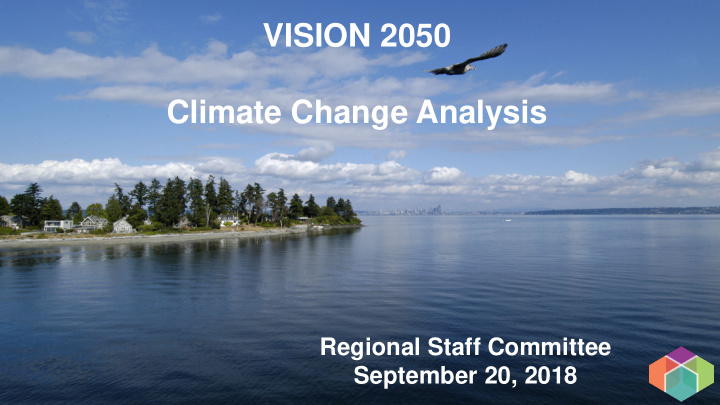



VISION 2050 Climate Change Analysis Regional Staff Committee September 20, 2018
VISION 2050 and Climate Change 1. Climate Background Paper: • Background information • Regional inventory • Emission reduction efforts • Potential opportunities 2. VISION 2050 Analysis • Analysis of Regional Growth Strategy alternatives 3. Continued implementation of adopted Four-Part Greenhouse Gas Strategy Slide #1
Regional Emission Trends • The region is meeting all federal and state air quality standards • Emissions continue to decline into the future, while population increases Limit 2017 - 2025: 41,290 lbs/day Limit 2026 - 2040: 22,880 lbs/day Today 2020 2025 2030 2035 2040 Nitrogen Oxides Limit 2017 - 2025: 1,888 lbs/day Limit 2026 - 2040: 1,321 lbs/day Today 2025 2040 Today 2020 2025 2030 2035 2040 Fine Particulates Carbon Dioxide Equivalents Slide #2
Current Four-Part Greenhouse Gas Strategy • Specific assumptions contained within each category • Complementary to the state program, other regional initiatives Slide #3
Regional Transportation Plan Analysis Assumptions include: Land • Adopted Regional Growth Strategy, as expressed in Choices Use adopted jurisdictional targets • Regional integrated transit network, regional bicycle network, projects & programs User Technology • Proposed financial strategy, including express toll Fees lanes, road usage charge, parking fees, certain facility tolls, etc. • Adopted CAFÉ and GHG vehicle standards, regional vehicle fleet characteristics, WA state parameters for fuel content, inspection programs, etc. • RTP analysis results in 2040 emissions ~24% below 2006 levels Slide #4
Regional Transportation Plan – Next Steps Additional / future work: Land • VISION 2050 – planning for growth out to 2050 Use • TOD analysis – scenarios for greater development/concentration of growth around transit stations • Potential of 2-4% additional reductions Additional / future work: Choices • Off-cycle analysis of pedestrian access to transit • Increase in telework, alternative work schedules, etc. • Potential of 1-2% additional reductions Slide #5
Regional Transportation Plan – Next Steps Additional / future work: User • Continued research on impact of various pricing mechanisms Fees • Review of pricing assumptions • Potential of 5% additional reductions Additional / future work: • Updated future technology scenarios, such as: Technology • Increased % of EVs in fleet, including shared ride EV assumptions • Further fuel and heavy duty improvements • Potential of 20-40% additional reductions Slide #6
Potential Regional Action Steps • VISION 2050 – planning for growth to 2050 • TOD implementation • Zoning and development changes • Continued policy focus on multimodal investments, access to transit • Policies and research to support telework and/or alternative work schedules • Support implementation of pricing in region • Support EV penetration in the region – • Zoning and other improvements to accommodate fast charging stations • Incentives / rebates / education for EV ownership and charging infrastructure • Policies and support for EVs in shared ride / carsharing services • Engage with current activities such as Electrify America, Clean Fleets • Continue collaboration / coordination with PSCAA Slide #7
Ongoing Coordination • PSCAA evaluating emission reduction strategies • Current focus is research of a low carbon fuel standard, and supporting the advancement of electric vehicles • PSRC continues to collaborate and provide technical assistance • PSRC will continue to monitor progress, and engage with PSCAA and others to implement the Source: PSCAA Four-Part Greenhouse Gas Strategy Slide #8
VISION 2050 • Greenhouse gas emissions to be analyzed for the Regional Growth Strategy alternatives • Part of the “what more can be done” under the Land Use scenario of the Four- Part GHG Strategy • VISION 2050 will subsequently inform the next Regional Transportation Plan • What’s next for Choices and Pricing • Continued regional coordination on advancing Technology • Identification of Next Steps and regional and local actions to implement the Four- Part GHG Strategy Slide #9
Recommend
More recommend